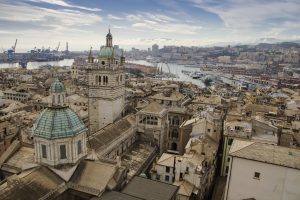The drive in, a milkshake, James Dean wearing his jeans: is there anything more quintessentially “americana” than this? As pleasant as it may be, we don’t need to take a trip down memory lane to realize how intertwined with American imagery and tradition blue jeans are. We usually, and rightly so, associate them with the figure of Levi Strauss and his almost forgotten friend Jacob Davis, who patented them in 1873. Strauss industries have become synonym with blue jeans all over the world, and they know it, to the point they didn’t bat an eyelid at spending almost 50.000 USD in 2001 to get their hands on a pair of vintage 19th century jeans found in a mine during excavations, to secure its pattern and sell an identical limited edition version for 300 USD shortly after.
Blue jeans were born as work pants for miners and gold diggers and were not even originally blue: Levi Strauss initially produced them with the sturdy fabric used to cover caravans, which was brown. Apparently, when he ran out of it and asked his New York city based brother to send over few batches of strong fabric to use, he picked what was most commonly used in the Big Apple port, a blue-colored cotton-based robust textile known as “blue de Gênes,” or Genoa Blue.
Why such a name, and what has the city of Genoa (Gênes is French for it) to do with the most famous american item of clothing in the world?

The origin of blue jeans: a northern italian affairs, with a hint of France
The history of jeans roots back, apparently, to the sleepy little town of Chieri (Turin) in the 15th century. In Chieri were the textile mills producing the strong fabric commonly used to cover materials and products on the ships departing the port of Genoa. A fabric of similar composition was also made in Nîmes, in the south of France, which was usually exported to – you guess it – Genoa, to make sailor trousers. The French called it “blue de Gênes” after its color, a name eventually distorted by English speakers in “blue jeans:” ask anyone who speaks French to say it quickly and you’ll notice yourself how much the two expressions sound alike. According to the Oxford Dictionary of the English Language, the term was used as early as 1567.
Fabric historians say the “blue de Gênes” fabric was the pretty blue sister of the already known fustian, largely used at the time to produce work pants and large protection cloths to use in commerce. Fustian was produced as early as the Middle Ages and was characterized by the association of a linen warp and a cotton weft.
Its blue variety became soon popular in Liguria, a fact supported by the many artistic attestations of it still extant: representations of regional costumes made in “blue de Gênes” abound, just as antique Nativity statuettes dressed in them. There is proof of its use also in a strictly worship and liturgical context, as demonstrated by the presence of several holy vestments, as well as a series of representations of the Passion of the Christ (the Teli della Passione), monochromatic paintings on “blue de Gênes” fabric, all kept in the Museo Diocesano di Genova.
If you find the jeans-Liguria connection hard to believe and happen to be around this beautiful region at some stage in your lifetime, look no further than the Museo Civico Etnografico G. Podenzana of La Spezia to see some examples of 18th and 19th century ligurian clothes made of it. The Galleria Nazionale Palazzo Spinola, in Genoa, also displays plenty of antique Nativity statues and statuettes clothed in blue. Are you more of a fine art lover? Then head to the Museo Civico Luxoro in Genoa Nervi, where a collection of antique watercolors also bear witness to the connection. Even in Rome’s own Museo Nazionale di Arti e Tradizioni, “blue de Gênes” ligurian costumes from the 18th and 19th centuries can be found.
From Northern Italy to the USA and back? Yes, it seems very much so.
Because of the fact the “blue de Gênes” fabric was so widely employed on Genoese ships, it is very likely it made it across the Atlantic and to New York easily. Once in the US, Levi Strauss turned this traditionally heavy duty ligurian textile into what was to become one of the most iconic clothing items of all times.
Blue jeans made their way back to Europe during the Second World War, when American soldiers would wear them while not in service: European fancied the blue pants so much they embraced them back immediately, many of them forgetting that, alas, they had been around Europe for centuries and centuries already.





























